How to measure
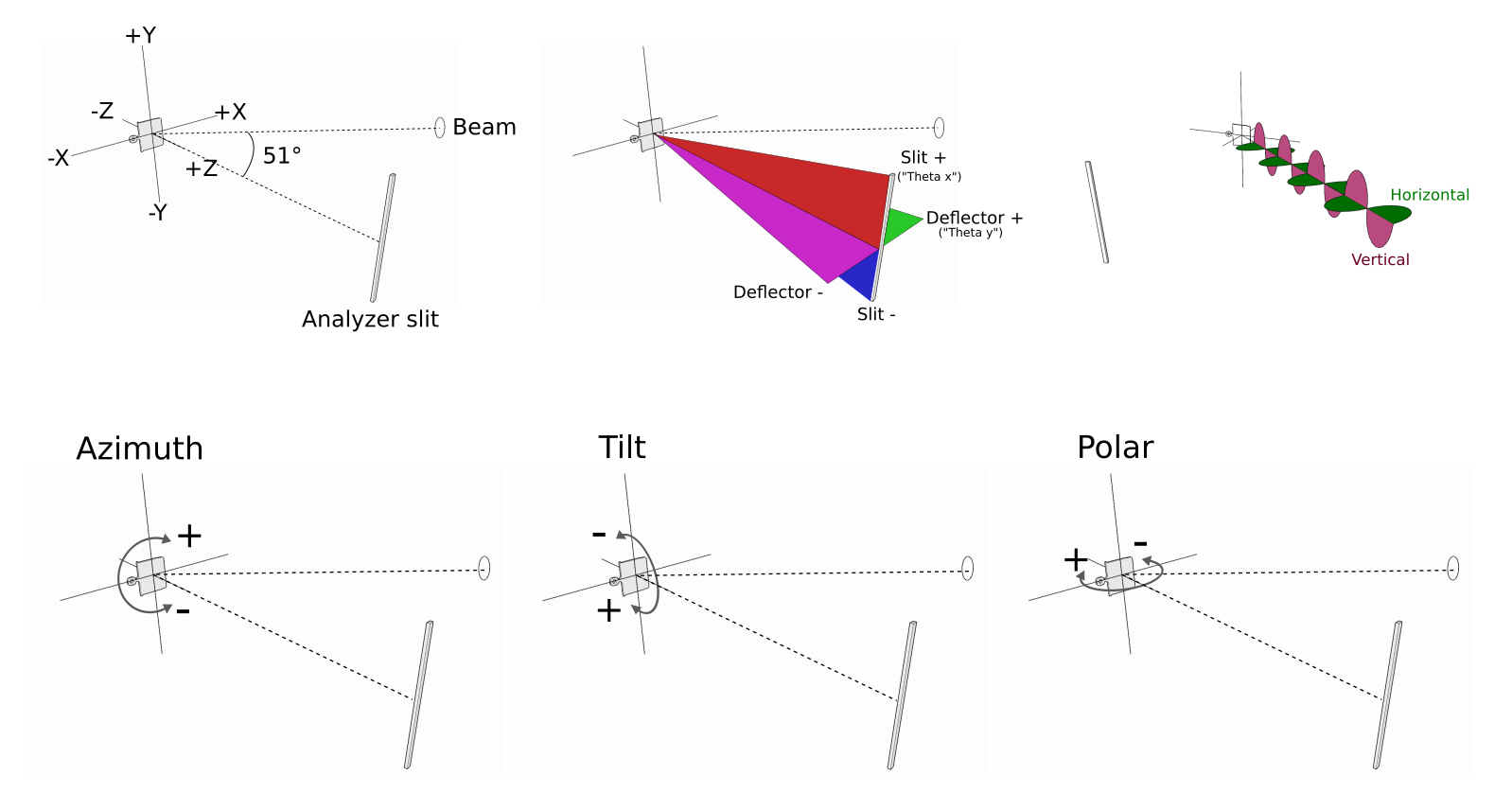
Maximum countrate
Excessive countrates will damage the MCP in the detector assembly, and at BLOCH it is very easy to generate unsafe countrates. Respect the following rules:
Maximum 1 million counts/s if everything is in a narrow stripe (for example transmission mode or graphene’s Dirac cone)
Maximum 10 million counts/s if intensity is evenly distributed across the detector
Core levels should be measured in an angular lens mode, except where lens table limits make this impossible.
Warning
There is no background process in SES to monitor countrates, so you must verify that the countrate is safe while in voltage calibration mode. If you will perform an angle scan or photon energy scan, check the intensity over the whole scan range, not just your starting position. If you will measure in swept mode, ensure that the intensity slightly below your starting point is also safe.
If you ever accidentally close the ‘SES Detector Viewer’ window in SES that shows a live stream of the detector, it can be reopened through Installation>Instrument>Dectector Interface>Setup>Filter:Real-time Monitor>Setup…
Sample camera
The sample camera feed is obtained through the Pylon Viewer software, launched from the desktop. The camera image can be panned (click+drag) or zoomed (ctrl+mousewheel) without losing the crosshair position. (See also the dedicated Basler sample cameras page). The primary chamber lighting is via a Zeiss CL6000 , with intensity manually adjusted by the knob on the front.
Control GUIs
How to launch control GUIs
For the control panels on the Windows spectrometer control computers, there is a folder on the desktop called ‘ControlGUIs’. Within this you will find all of the control GUIs discussed below. All of them have a corresponding ‘Launch’ shortcut that you can double click on.
For the control panels on the ‘beamline’ control computer (Linux) there is a ‘Bloch controls GUI’ shortcut on the desktop that brings up a launcher for all the sub-panels.
There is some redundancy between what you can do with the controls on the two different computers. As a general rule, the panels on the Linux computer are more full featured while those on the Windows computer are simplified cover only what you need to perform an experiment. Those who are measuring remotely through a VPN connection can only access the Windows computer.
Manipulator control (Windows computer)

This panel controls the Carving 6-axis manipulator motion. Axes can be toggled between relative and absolute motion, and nothing will happen until you click the ‘Go’ button.
The motion in this interface is software restricted to a safe bounding volume, so in principle it should not be possible to crash the manipulator into anything.
You will be using either the z-axis or ‘hv’ axis to bring the sample into focus perpendicular to the slit; start with steps of 0.1 but once you’re approaching the optimal fine tune in steps of 0.02. Focusing is discussed in more detail on the ‘DA30’ page)
If you are scouting around the sample and want to ‘bookmark’ good positions you find, the ‘Save current position’ button will do this. Pressing the ‘recall’ button for a saved position will populate the ‘Desired’ fields for the 6 axes, but nothing will move until you press ‘Go’ for each of these axes one by one.
You should only need to manually adjust the Carving position when you are measuring - going up and down between the measurement and transfer positions is performed as pre-programmed paths in order to avoid collisions. These motions are currently only possible from the Linux control computer, you cannot do them from the Windows computer.
‘Automap’ Windows computer)

The Manipulator control panel is also keeping a continuous record of every position you have visited, where ‘visited’ means you have stayed there for a few seconds. You can find this record as a plain-text file in the ControlGUIs folder. The Automap panel continuously monitors this record and produces an X-Y ‘birds-eye’ view of your position history. This is useful for visualizing where you have (and have not) been, and the colored buttons on the right allow you to manually label positions of interest.
Red cross: where you are right now
Hollow circle: somewhere you have been
Filled circle: somewhere you have labelled
With the mouse you can pan and zoom the map, and also select a position you would like to move to.
The second facet of this panel is an easier way to perform X-Y raster scan measurements. The bottom section of the panel allows you to draw a region that you would like to scan (click and drag), and then fine tune the position grid by editing step size or start/end positions. You can then either perform the scan directly without recording any spectra to file, OR general a valid SES sequence containing a pre-defined manipulator scan region. This is a vastly easier way to set up spatial maps in SES compared to the native interface.
Temperature control panel (Windows computer)
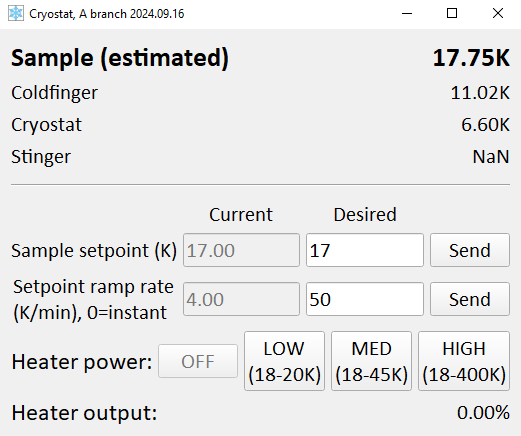
This panel controls the Lakeshore controller, which measures the cryostat temperatures and runs the counter-heater. See the detailed discussion on the ‘Carving’ page for information on how to interpret the temperatures shown here. Inputs here are:
Sample setpoint: What temperature you want to have on the sample. Note that nothing will happen if the heater power is set to ‘OFF’
Ramp rate: How fast the sample setpoint is allowed to change
Heater power: Maximum power the control loop is allowed to give the heater. Each button indicates the temperature range that can be achieved for that setting. It is typical to choose either ‘OFF’ (for base temperature) or ‘HIGH’ (anything else)
Trendplots (Windows computer)
Simple temperature and pressure trendplot panels are available. These will only start plotting data from the time they were launched onwards.
Launcher panel (Linux computer)
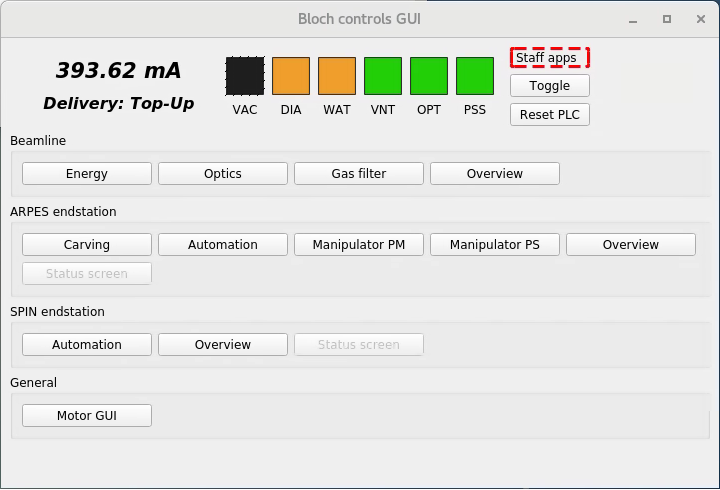
From here you launch other panels with specialized functions. As a user you will be mostly interacting with the ‘Carving’ (manipulator control) and ‘Energy’ (beamline control) panels.
Carving panel (Linux computer)
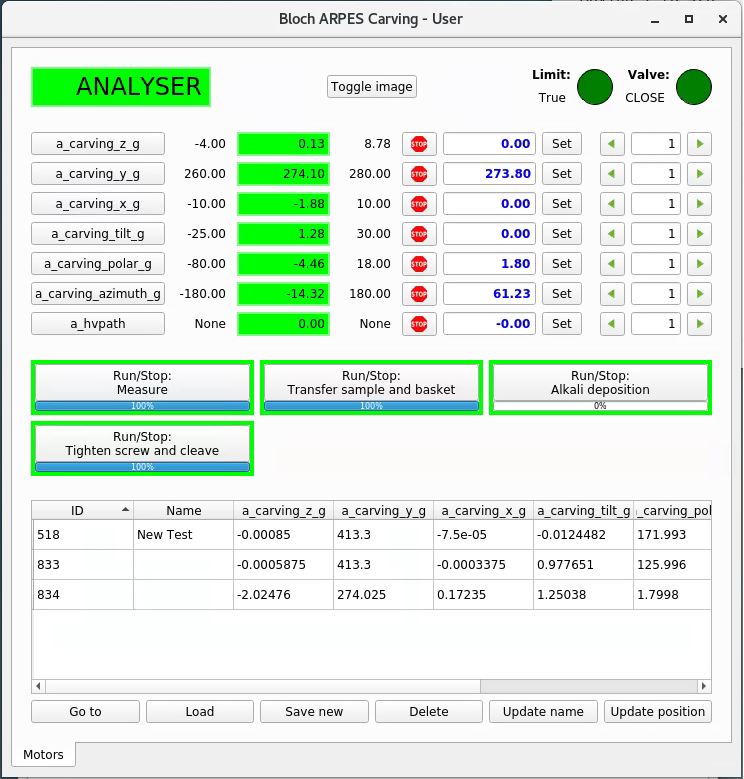
Similar to the ‘Manipulator control’ on the Windows computer, except now you have some additional buttons to initiate movement between the major positions. These are:
Measure |
Put the sample in front of the analyzer |
Transfer sample and basket |
Pick up samples from the transfer arm and insert them into the manipulator |
Alkali deposition |
Place the sample in front of the alkali source (see Alkali deposition page) |
Tighten screw and cleave |
Tighten/loosen the two clamping screws on the manipulator, and/or cleave a sample |
There are two indicators in the top right of this panel. Both must be green before the movement buttons will work. ‘Valve’ means the gate valve to the transfer chamber (which must be closed). ‘Limit’ means the manipulator position is somewhere abnormal and needs to be manually moved back into a predefined bounding volume. Beamline staff can help you with this.
Warning
Always retract both wobblesticks fully after you have used them. If they are left pushed into the chamber, the manipulator can catch on them and cause major damage when it moves between positions.
Using SES
Measurements at Bloch are taken through Scienta’s ‘SES’ software, v1.9.2. You will find a shortcut to it on the desktop. Manuals are here (pdf) and here (pdf)
Preliminary notes about SES:
Regions, sequences and iterations
All measurements happen by configuring them in the sequence editor, then running the sequence.
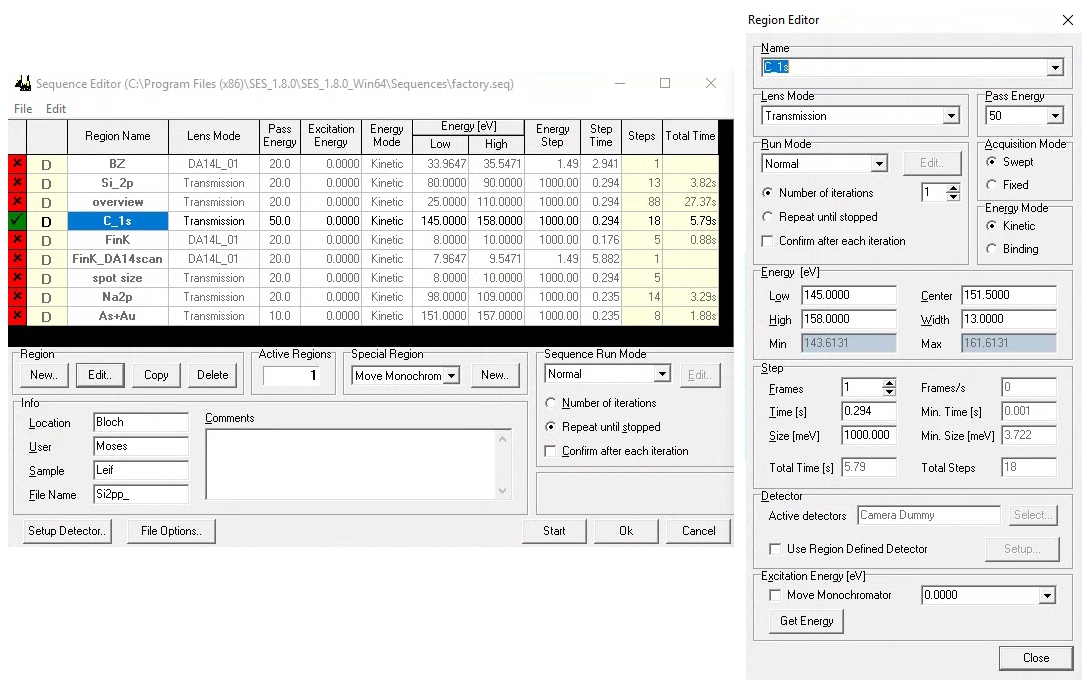
When programming a measurement in the sequence editor, SES offers several layers of hierarchy. The terminology can be confusing:
A sequence is a list of measurements you wish to perform. Each entry in that list is called a region. Some types of regions can have more than one iteration (or what we might call sweeps).
Programming a complicated multi-measurement sequence is common for XPS, but in ARPES it is more common to have only one active region in the sequence at a time. Typically one might like to leave that measurement integrating indefinitely, manually stopping when you are satisfied with the quality. There are different permutations that accomplish this, but they are not all equivalent!
The most important difference is that the measurement is saved to disk when a region is completed. This means that if you set multiple region iterations, nothing will save until it has finished (either naturally or by you asking it to stop).
Advantage: Less time spent writing to disk
In contrast, if you set the iterations at the sequence level, the measurement will be saved after every iteration.
Advantage: Data is safer against SES crashes
Advantage: You can access the data in external analysis software while SES continues to update it in the background.
If you really want to break your long DA30 scan into multiple iterations, there is a way around this. If the sequence contains multiple identical DA30 scan regions, you will end up with one zip file containing several .bin files. You would then be able to manually combine them if desired. It is not saved until the end, so you can’t look at it while it measures.
File formats
When configuring the savefile path (File Options in sequence editor) you can also choose which file formats to save to. DA30 scans are always and only .zip files, but everything else can be any or all of (.pxt, .ibw and .txt). Choose whatever your analysis software takes, but note that large scans (big manipulator maps or hv scans) saved to txt can cause memory issues and crash SES. Don’t save to txt unless you really need it. You can always use SES to convert between file formats afterwards.
Deflector ARPES scans
See also the discussion on the see DA30 page), especially regarding focusing, exit slit aperture and fixed vs. scanned modes.

Comments:
SES does not automatically rezero the deflectors when it completes a DA30 angular map! Manually re-zero it using the DA30 menu in the main SES window.
Fast DA30 angle maps (2-3s/frame in fixed mode) combined with the pesto ‘align’ function are a useful method of quickly evaluating and correcting the angular alignment of your sample.
View measurements in pesto with pesto.explorer(“filename.zip”)
1D manipulator scans (e.g. Fermi surface maps)
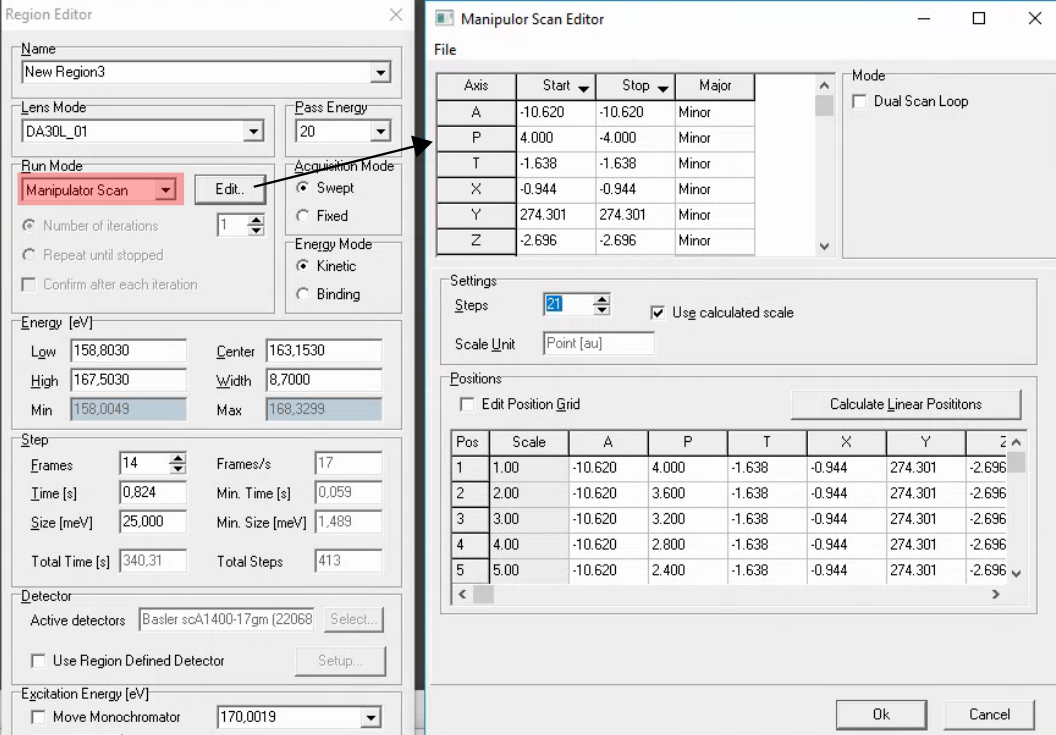
Comments:
You can right click on the ‘Start’ and ‘End’ cells in the top row to set to the current manipulator position. But still always double check that the values are correct, and always check that any axis that shouldn’t be moving has the same starte and stop value.
Don’t forget to mark the axis you are scanning as a major axis
If it is a polar scan and the range is more than 5-10 degrees, in order to maintain reasonable focus you will need to be close to the manipulator center of rotation (approximately x=0.185) and you may need to scan z along with polar.
Nothing is saved until the end, and the SES viewer unhelpful just concatenates all scans. It is typically worth first running a very fast version of the measurement to ensure that all settings are correct, that your settings are safe for the highest intensity regions of the scan and that you will get what you want.
View measurements in pesto with pesto.explorer(“filename.ibw”)
Time dependent scans
A hack workaround for time dependent scans is to program a 1D manipulator scan in which the start and end polar values are within 0.01 degrees of each other. The logic layer between SES and the control system filters out any motion requests that are below a certain threshold, so a scan like this will result in no motion at all.
This can also serve as a hack workaround for temperature dependence, if you pair it with a suitably slow temperature ramp. In this case, make sure to save a copy of the temperature log file that is saved to the ControlGUIs folder.
Photon energy scans

Comments:
This is enabled by a special addition to give SES access to the same ‘beamline energy’ input you control, which simultaneously sets the monochromator energy and EPU gap. It will work for all polarization modes, but you still need to manually toggle between polarizations - changing polarization within SES is not currently possible. (Note for staff: details of the implementation are described in elogy.)
If you just want to measure a few different photon energies, it is also possible to insert a special region in the sequence editor that changes the photon energy
When changing photon energy, SES will wait a certain amount of time (120s) then just move on with the sequence regardless of whether the monochromator has finished moving. At lower energies the monochromator becomes progressive slower to move, so it is generally a good idea to already be at the starting photon energy for an hv scan. For the same reason, when using the special ‘set hv’ region in the sequence editor it can pay to set it twice in a row if there is any risk that 120s will not be long enough to complete the move.
For photon energy scans you will have to specify the measurement range in binding energy. The work function is currently set to zero in SES, so Eb = hv - Ek. The easiest approach is to switch to binding energy scale in voltage calibration mode and read off the start and end values you want to scan over.
Nothing is saved until the end, and the SES viewer unhelpful just concatenates all scans. There is a separate viewer window which shows the angle-integrated spectrum as a function of hv, which can be helpful just to know that something is happening:
It is typically worth first running a fast, coarse version of the measurement to ensure that all settings are correct, that your settings are safe for the highest intensity regions of the scan and that you will get what you want.
View measurements in pesto with pesto.explorer(“filename.ibw”)
2D manipulator maps (e.g. X-Y spatial maps)
Note
It is highly recommended to configure X-Y map regions via the ‘Automap’ control panel instead of configuring them manually within SES.
To scan two manipulator axes, most typically X and Y for a spatial map, check the ‘dual scan loop’ box when setting up a manipulator scan. You can now choose two major axes and assign one to the inner and one to the outer scan loop.
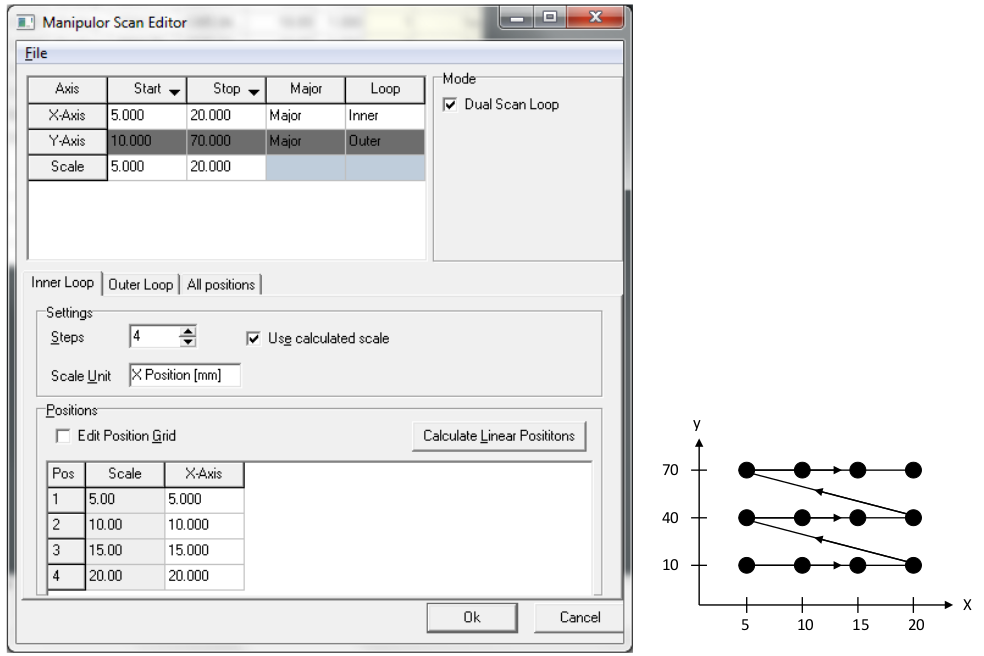
Comments:
It is a good idea to talk to one of the beamline staff before first attempting one of these measurements - there are several special considerations to keep in mind
The ibw data format used by SES is fundamentally incompatible with file sizes larger than 2Gb. If your scan exceeds this, it will be corrupted. As a general rule of thumb, 20x20 maps will work when acquiring full-frame fixed mode images. To make larger scans, you will need to enable angle binning and/or reduce the detector frame size in order to produce smaller files. You can configure this from the main window in SES under Setup>Global detector. Binning is enabled by setting the ‘Slices’ field to some integer fraction of the maximum, e.g. 400 slices out of a possible 800 corresponds to binning by a factor of two. XPS maps in transmission mode can use aggressive binning without any compromise. Remember to return to full resolution settings after the map!
It is highly recommend to set up 2D scans from the ‘Automap’ panel instead of configuring them manually within SES. When loading the sequences files produced by that panel, a bug in SES will usually corrupt the final position list. You must force SES to recalculate it by changing the number of points in the inner and outer loop (i.e. increment by one then decrement by one)
There is a preferred scan direction (positive) to avoid triggering backlash compensation every step. In the Automap panel this is accomplished by dragging from upper right to lower left when defining the scan region.
These measurements involve a lot of measurements and so take a long time. Scanned mode ARPES is often infeasible, so use fixed mode wherever possible.
Step sizes down to approximately 10μm in X and Y are reasonable. Steps below 5μm start to exceed the capabilities of the XYZ stage and can be unreliable.
If configuring the scan manually in SES: You can right click on the ‘Start’ and ‘End’ cells in the top row to set to the current manipulator position. But still always double check that the values are correct, and always check that any axis that shouldn’t be moving has the same starte and stop value. Check this on each of the ‘inner loop’, ‘outer loop’ and ‘all positions’ tab - SES will try very hard to trip you up, so be vigilent.
Data can be viewed in pesto with pesto.explorer(“filename.ibw”)